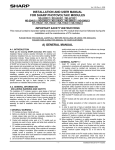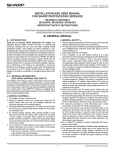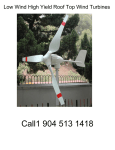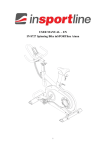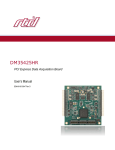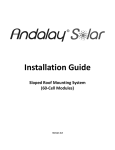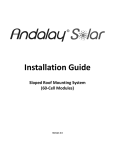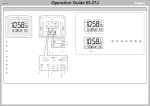Download INSTALLATION MANUAL AND USER MANUAL FOR SHARP
Transcript
Ver. 1.0UJ Aug 25, 2008 INSTALLATION MANUAL AND USER MANUAL FOR SHARP PHOTOVOLTAIC MODULES ND-123UJF / ND-130UJF PLEASE READ THIS MANUAL CAREFULLY BEFORE INSTALLING OR USING THE MODULES. PLEASE PASS ALONG THIS MANUAL TO YOUR CUSTOMER. A) GENERAL MANUAL 2. Install PV modules and ground frames and other metal components in accordance with applicable codes and regulations. 3. PV modules should be installed and maintained by qualified personnel. Only installation/service personnel should have access to the PV module installation site. 4. When PV modules are installed on roofs or any other structures above ground, appropriate safety practices should be followed and appropriate safety equipment should be used in order to avoid possible safety hazards. Note that the installation of PV modules on some roof types may require the addition of fireproofing, as required by local building/fire codes. 5. Roof mounted PV modules are to be mounted over a fire resistant roof. 6. Only PV modules with the same cell size should be connected in series. 7. Follow all safety precautions of other components used in the system. 8. In order to avoid risk of injury or electrical shock, do not allow anyone to handle damaged PV modules if the person is unqualified or has limited knowledge of PV modules. 9. Avoid uneven shade on the PV module surface. Shaded cells may become hot (“hot spot” phenomenon) which may result in permanent damage to the module (e.g., solder joints may peel off). 10. Do not clean the glass surface with chemicals. Do not let water stay on the glass surfaces of PV modules for a long time. This creates a risk of permanent damage to the glass, such as white efflorescence, otherwise known as “glass disease,” which may cause reduced power output. 11. To avoid dirt accumulation or white efflorescence due to water accumulation, do not install PV modules horizontally (flat). 12. Do not cover the water drain holes of the frame. There is a risk of frost damage when the frame is filled with water. 13. In high snow load regions, appropriate measures are to be taken so that PV module frames (on lower edges of the modules) will not be damaged. 14. Do not expose PV modules to sunlight concentrated with mirrors, lenses or other means. 15. Turn off inverters and circuit breakers immediately, should a problem occur. 16. A defective PV module or module with broken glass may generate power even if it is removed from the system. It may be dangerous to handle the defective PV module while exposed to sunlight. Place defective PV modules in cartons so PV cells are completely shaded. 17. The maximum open circuit voltage must not be greater than the specified maximum system voltage. Voltage is proportional to the number of PV modules in series and is affected by weather conditions. For strings connected in parallel take proper measures to block reverse current flow. 18. Keep children away from PV modules. A-1. INTRODUCTION This Installation Manual contains essential information for electrical and mechanical installation that you must know before installing SHARP photovoltaic (PV) modules. These modules are UL listed (UL 1703). This Manual also contains safety information you need to be familiar with. All the information described in this Manual is the intellectual property of SHARP and is based on the technologies and experience that have been acquired and accumulated over the long history of SHARP. This Manual does not constitute a warranty, expressed or implied. SHARP does not assume responsibility and expressly disclaims liability for loss, damage, or expense arising out of or in any way connected with installation, operation, use or maintenance of PV modules. No responsibility is assumed by SHARP for any infringement of patents or other rights of third parties that may result from use of PV modules. SHARP reserves the right to make changes to the product, specifications or Installation Manual without prior notice. A-2. GENERAL INFORMATION (INCLUDING WARNING AND SAFETY) The installation of PV modules requires a great degree of skill and should only be performed by qualified licensed professionals, including licensed contractors and licensed electricians. Please be aware that there is a serious risk of various types of injury occurring during the installation including the risk of electric shock. These SHARP PV modules are equipped with a permanently attached junction box for ease of installation of wires and conduit. < GENERAL WARNING > 1. PV modules are heavy. Handle with care. 2. Before you attempt to install, wire, operate and maintain the PV module, please make sure that you completely understand the information described in this Installation Manual. 3. Contact with electrically active parts of a PV module such as terminals can result in burns, sparks and lethal shock whether the PV modules are connected or not. 4. PV modules produce electricity when sufficient sunlight or other light source illuminates the module. When modules are connected in series, voltage is cumulative. When modules are connected in parallel, current is cumulative. PV systems can produce high voltage and current which could present an increased hazard and may cause serious injury or death. 5. Do not connect PV modules directly to motor loads. Variation in PV module output power as a function of solar irradiance may damage directly-connected loads. For example, 1: In the case of a brushless motor, the lock function may become active and the motor may be damaged; 2: In the case of a brush type motor, the coil may be damaged. < GENERAL SAFETY > 1. Consult local codes and applicable laws concerning required permits and regulations concerning installation and inspection requirements. -1- Installation Manual for PV modules Ver. 1.0UJ Aug 25, 2008 disconnected from the system. 12. Do not unplug a connector if the system circuit is connected to an operating load. 13. Do not work alone (always work as a team of 2 or more people). 14. Wear a safety harness when working above the ground. 15. Do not wear metallic jewelry which may conduct electricity and enable electric shock during installation. 16. Do not damage the back sheet of PV modules when fastening the PV modules to a support by bolts. 17. Do not damage the surrounding PV modules or mounting structure when replacing a PV module. 18. Use UV resistant materials, wire management hardware to secure cables. Drooping cables may cause various problems, such as electricity leakage. 19. Take proper measures for preventing the laminate (consisting of encapsulant, cells, glass, back sheet, etc.) from dropping out of the frame in case the glass is broken. 20. Cables shall be located so that they will not be exposed to direct sunlight in order to prevent degradation of cables. < HANDLING SAFETY > 1. Do not expose the PV module to excessive loads on the surface of the PV module or twist the frame. The glass may break. 2. Do not stand or step on the PV module. The glass may be slippery, and there is a risk of injury or electric shock if glass is broken. 3. Do not hit or put excessive load on the glass or back film. PV cells may break. 4. To avoid damage to the back sheet, do not scratch or hit the back sheet. 5. To avoid damage to the junction box, do not hit the junction box; do not pull the cables. 6. Never touch the end of output cables with bare hands when the module is illuminated. Cover the surface of module with cloth or other sufficiently opaque material to block the module from incident light and handle the wires with insulated gloved hands to avoid electric shock. 7. Do not scratch the output cable or bend it with force. The insulation of the output cable may break which may result in electricity leakage or shock. 8. Do not pull the output cable excessively. The output cable connection may become loose and cause electricity leakage or shock. 9. Do not drill holes in the frame. It may compromise the frame strength and cause corrosion of the frame. 10. Do not scratch the insulation coating of the frame (except for grounding connection). It may cause corrosion of the frame or compromise the frame strength. 11. Do not loosen or remove the screws from the PV module. It may compromise the strength of the PV module and cause corrosion. 12. Do not touch the PV module with bare hands. The frame of the PV module has sharp edges and may cause injury. Wear suitable gloves, such as leather gloves with padding in the palm and finger areas. 13. Do not drop the PV module or allow objects to fall on the PV module. 14. Do not lift the PV module by only one side. The frame may bend. Always use two hands to lift and carry the PV module on the long side of the frame. 15. Some PV modules incorporate one or more support bars on the back of the module. Do not mount or carry the PV module using the support bar(s) on the back of the module. A-3. PV MODULE COMPONENTS A-4. SITE SELECTION PV modules should be installed in a location where there is no shading throughout the year. In the northern hemisphere, PV modules should typically face south, and in the southern hemisphere, PV modules should typically face north. Please make sure that there are no obstructions in the surroundings of the site of installation. Take proper steps in order to maintain reliability and safety in case the PV modules are installed in areas that have heavy snow / extreme cold / strong winds / installations over, or near, water and areas where installations are prone to salt water exposure or on small islands or in desert areas. If you are planning to use the PV modules where salt water damage may occur, please consult with SHARP to determine an appropriate installation method, or if installation is possible. < INSTALLATION SAFETY > 1. Always wear protective head gear, insulating gloves and safety shoes (with rubber soles). 2. Keep the PV module packed in the carton until installation. 3. Do not touch the PV module unnecessarily during installation. The glass surface and the frame may be hot. There is a risk of burns and electric shock. 4. Do not work in rain, snow or windy conditions. 5. Use insulated tools. 6. Do not use wet tools. 7. When installing PV modules, do not drop any objects (e.g., PV modules or tools). 8. Make sure flammable gases are not generated or present near the installation site. 9. Terminate module-to-module wires in the junction box fully and correctly. Check all connections. 10. Due to the risk of electrical shock, do not perform any work if the terminals of the PV module are wet. 11. Do not touch the junction box and the end of the output cables (connectors) with bare hands during installation or under sunlight, regardless of whether the PV module is connected to or -2- Installation Manual for PV modules Ver. 1.0UJ Aug 25, 2008 mounting hole or hardware that is used for structurally mounting the module. UL 1703 prohibits the use of a bonding fastener for any purpose other than ground bonding. A-5. TILT ANGLE SELECTION The tilt angle of the PV module is measured between the surface of the PV module and a horizontal ground surface. The PV module generates maximum output power when it faces the sun directly. For standalone systems with batteries where the PV modules are attached to a permanent structure, the tilt angle of the PV modules should be selected to optimize the performance based on seasonal load and sunlight. In general, if the PV output is adequate when irradiance is low (e.g., winter), then the angle chosen should be adequate during the rest of the year. For grid-connected installations where the PV modules are attached to a permanent structure, PV modules should be tilted so that the energy production from the PV modules will be maximized on an annual basis. A-7. MAINTENANCE SHARP PV modules are designed for long life and require very little maintenance. If the angle of the PV module is 5 degrees or more, normal rainfall is usually sufficient to keep the module glass surface clean under most weather conditions. If dirt build-up becomes excessive, clean the glass surface only with a soft cloth using water. If cleaning the back of the module is required, take utmost care not to damage the back side materials. In order to ensure proper operation of the system, please check all wiring connections and the condition of the wire insulation periodically. A-6. ELECTRICAL INSTALLATION To ensure proper system operation and maintain the warranty, be careful to observe the correct cable connection polarity (Figure 1) when connecting the modules to a battery or to other modules. If not connected correctly, the bypass diode(s) could be destroyed. All PV modules must be grounded by electrical connection of the module frames to ground. Care must be taken to arrange the system ground so that the removal of one module from the circuit will not interrupt the grounding of any of the other modules. For grounding, each PV module has a hole in the frame for either a bolt, nut and washer, a ground lug fastened by bolt or screw, or an appropriate screw (hardware not provided). Installation for wiring shall be in accordance with the NEC and grounding method shall comply with the NEC, article 250 and the relevant instructions below. In a connection of this type, the hardware (such as a star washer) must score the frame surface to make positive electrical contact with the frame. The ground wire must not be smaller than No.14 AWG (2.1 mm2), and should be sized according to the NEC. Hardware used must be compatible with the mounting structure material to avoid galvanic corrosion. The module junction box is shown in Figure 2. When connecting the modules to a battery or to other modules, you must carefully observe correct cable connection polarity as shown Figures 1 and 4. If not connected correctly, the bypass diodes could be destroyed. This will void your warranty. Open the cover of the junction box by loosening the two cover screws as shown in Figure 2. Figure 3 shows the inside of the junction box. Typical terminal cabling is AWG 14, but will be dependent upon system design as guided by the National Electrical Code. Remove the appropriate grommets and route the interconnecting cables through grommets as shown in Figure 3. To remove the grommets, push them from inside of the box. To connect wires to the terminal block, a wire lug connector may be used as shown in Figure 6. For direct wiring, strip back insulation about 16mm (5/8”) and wrap stripped wire around screw under square washer as shown in Figure 7. Tighten terminal screw securely with a proper screwdriver. After completed terminal wiring, secure the cover of the junction box. SERIES WIRING (VOLTAGE ADDITIVE) + - + - + - + PARALLEL WIRING (CURRENT ADDITIVE) + - + - + - + Figure 1 Grounding Using Existing Ground Hole (Figure 8) The existing ground holes can be used with stainless steel #10-32 bolts, #10 lock washers and #10-32 nuts. All grounding hardware must have a thread count of at least 32 turns per inch. These holes may be used to secure an outdoor-rated, tinned copper, UL listed lay in ground lug such as Ilsco model GBL4-DBT or equivalent. Grounding Using Existing Unused Module Mounting Hole (Figure 9) An existing otherwise unused module mounting hole can be used to install the same grounding hardware noted above. Do not use a Loosen the two cover screws to open the cover Figure 2 -3- Installation Manual for PV modules Ver. 1.0UJ Aug 25, 2008 Figure 6 Remove the appropriate grommets. (Push them from inside of the box) Figure 3 Figure 7 1 2 3 1 2 : Negative Terminal 3 4 : Positive Terminal 4 Lay in Ground Lug Figure 8 Figure 4 Figure 9 Figure 5 -4- Installation Manual for PV modules Ver. 1.0UJ Aug 25, 2008 B) MODULE SPECIFIC INSTRUCTIONS ND-123UJF / ND-130UJF MECHANICAL INSTALLATION D Please review the descriptions below and drawings carefully; not mounting the modules according to the described method may void your warranty. Additionally, UL has tested and listed these modules for mounting using bolts. D C Mounting Using Frame Bolt Holes (Figure 10 & 11) The modules may be fastened to a support using the bolt holes in the bottom of the frame at location “C”, as shown in Figure 11 (back view of the module) and Figure 10 (mounting detail). The module should be fastened with four (4) M8 (5/16”) bolts. The mounting method is designed to withstand loads of 2400 Pa. Take care during installation to not block the drain holes (D) shown in Figure 11. C D SOLAR MODULE WASHER BOLT mm BOLTM8 M8XX20 20mm C WASHER SPRING WASHER NUT C D Figure 10 Figure 11 D C) ELECTRICAL INFORMATION ELECTRICAL RATINGS Rated electrical characteristics are within ±10 percent of the indicated values of Isc, Voc and within +10/-5 percent of Pmax under Standard Test Conditions (irradiance of 100 mW/cm2, AM 1.5 spectrum, and a cell temperature of 25˚C (77˚F)). The warranty conditions are specified elsewhere in this manual. Maximum Power (Pmax) Open-Circuit Voltage (Voc) Short-Circuit Current (Isc) Voltage at maximum power (Vpmax) Current at maximum power (Ipmax) Maximum System Voltage Minimum Blocking diode Maximum Series Fuse ND-123UJF 123.0 W 21.78 V 7.99 A 17.21 V 7.15 A 600 V 15 A 15 A ND-130UJF 130.0 W 21.90 V 8.20 A 17.40 V 7.50 A 600 V 15 A 15 A Under normal conditions, a PV module may produce more current and/or voltage than reported at Standard Test Conditions. Accordingly, the values of Isc and Voc marked on UL 1703 listed modules should be multiplied by a factor of 1.25 when determining component voltage ratings, conductor ampacities, fuse sizes and size of controls connected to the module output. Refer to Sec. 690-8 of the National Electric Code for an additional multiplying factor of 125 percent (80 percent de-rating) which may be applicable. Where Canadian UL listing applies, installation shall be in accordance with CSA C22.1, Safety Standard for Electrical Installations, Canadian Electrical Code, Part 1. -5- Installation Manual for PV modules Ver. 1.0UJ Aug 25, 2008 SHARP ELECTRONICS CORPORATION PHOTOVOLTAIC MODULE LIMITED WARRANTY This Limited Warranty applies to photovoltaic modules manufactured by SHARP with the following model numbers: ND-123UJF/ND-130UJF. Limited Warranty For Materials or Workmanship: Sharp Electronics Corporation warrants to the first consumer purchaser that this Sharp brand product (the “Product”), when shipped in its original container, will be free from defective workmanship and materials, and Sharp agrees that for a period of one (1) year from the date of purchase by the consumer, that Sharp will, at its option, either repair the defect or replace the defective Product or part thereof with a new or remanufactured equivalent at no charge to the purchaser for parts or labor for the period(s) set forth below. Limited Warranty For Power: The warranty period with respect to power output continues for a total of 25 years from date of purchase by the consumer, the first 10 years at 90% minimum rated power output and the balance of 15 years at 80% minimum rated power output. This warranty is transferable when product remains installed in original location at the time of product warranty registration. This warranty does not apply to any alteration of the appearance of the Product that does not affect the performance or functionality of the Product, nor to the additional excluded item(s) set forth below nor to any Product, in Sharp’s sole discretion, the exterior of which has been damaged or defaced, which has been subjected to misuse, abnormal service or handling, or which has been altered or modified in design or construction. In order to enforce the rights under this limited warranty, the purchaser should follow the steps set forth below and provide proof of purchase to the servicer. The limited warranty described herein is in addition to whatever implied warranties may be granted to purchasers by law. ALL IMPLIED WARRANTIES INCLUDING THE WARRANTIES OF MERCHANTABILITY AND FITNESS FOR USE ARE LIMITED TO THE PERIOD(S) FROM THE DATE OF THE PURCHASE SET FORTH BELOW. Some states do not allow limitations on how long an implied warranty lasts, so the above limitation may not apply to you. Neither the sales personnel of the seller nor any other person is authorized to make any warranties other than those described herein, or to extend the duration of any warranties beyond the time period described above on behalf of Sharp. The warranties described herein shall be the sole and exclusive warranties granted by Sharp and shall be the sole and exclusive remedy available to the purchaser. Correction of defects, in the manner and for the period of time described herein, shall constitute complete fulfillment of all liabilities and responsibilities of Sharp to the purchaser with respect to the Product and shall constitute full satisfaction of all claims, whether based on contract, negligence, strict liability or otherwise. In no event shall Sharp be liable, or in any way responsible, for any damages or defects in the Product which were caused by repairs or attempted repairs performed by anyone other than an authorized servicer. Nor shall Sharp be liable or in any way responsible for any incidental or consequential economic, property or special damage. Some states do not allow the exclusion of incidental or consequential damages, so the above exclusion may not apply to you. THIS WARRANTY GIVES YOU SPECIFIC LEGAL RIGHTS. YOU MAY ALSO HAVE OTHER RIGHTS, WHICH VARY FROM STATE TO STATE. SHARP ELECTRONICS CORPORATION Sharp Plaza, Mahwah, New Jersey 07495-1163 -6- Installation Manual for PV modules Ver. 1.0UJ Aug 25, 2008 Additional Item(s) Excluded from Warranty Coverage Warranty coverage does not apply when: a) the product is installed or repaired or serviced in a manner that is contrary to Sharp’s Installation Manual; b) the product is installed in a mobile or marine environment, subjected to improper voltage or power surges or abnormal environmental conditions (such as acid rain or other pollution); c) the components in the construction base on which the module is mounted are defective; d) external corrosion, mold discoloration or the like occurs; e) the product has been moved from its original installation; f) the model number or serial number of the product is altered, removed or rendered illegible. Sharp’s aggregate liability in connection with the Product, if any, shall not exceed the purchase price paid to Sharp for the Product or service which gave rise to the claim under the Limited Warranty. The repair, replacement of the Product, or the supply of additional Product does not cause the beginning of new warranty terms, nor shall the original warranty terms of this Limited Warranty be extended. Any replaced product shall become Sharp’s property Where to Obtain Service: Warranty service is available at a Sharp Authorized Dealer located in the United States. To find the location of the nearest Sharp Authorized Dealer, call Sharp toll free at 1-800 SOLAR06 (800-765-2706). Call toll free at 1-800-765-2706 to obtain a Return Authorization Number and shipping instructions. Proof of Purchase will be required. What to do to Obtain Service: Ship prepaid or carry in your Product to a Sharp Authorized Dealer. Be sure to have Proof of Purchase available. If you ship the Product, be sure it is insured and packaged securely. Sharp will not be responsible for the costs of de-installation or reinstallation. SHARP ELECTRONICS CORPORATION Sharp Plaza, Mahwah, New Jersey 07495-1163 -7- Installation Manual for PV modules








